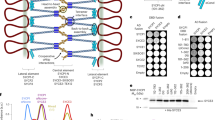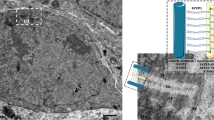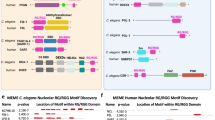Abstract
The synaptonemal complex (SC) is a proteinaceous structure that forms between homologous chromosomes during meiosis prophase. The SC is widely conserved across species, but its structure and roles during meiotic recombination are still debated. While the SC central region is made up of transverse filaments and central element proteins in mammals and fungi, few central element proteins have been identified in other species. Here we report the identification of two coiled-coil proteins, SCEP1 and SCEP2, that form a complex and localize at the centre of the Arabidopsis thaliana SC. In scep1 and scep2 mutants, chromosomes are aligned but not synapsed (the ZYP1 transverse filament protein is not loaded), crossovers are increased compared with the wild type, interference is lost and heterochiasmy is strongly reduced. We thus report the identification of two plant SC central elements, and homologues of these are found in all major angiosperm clades.
This is a preview of subscription content, access via your institution
Access options
Access Nature and 54 other Nature Portfolio journals
Get Nature+, our best-value online-access subscription
$29.99 / 30 days
cancel any time
Subscribe to this journal
Receive 12 digital issues and online access to articles
$119.00 per year
only $9.92 per issue
Buy this article
- Purchase on Springer Link
- Instant access to full article PDF
Prices may be subject to local taxes which are calculated during checkout








Similar content being viewed by others
Data availability
The raw read data for Fig. 7 can be found in the EBI ArrayExpress database under accession number E-MTAB-12985 (https://www.ebi.ac.uk/biostudies/studies/E-MTAB-12985).
Code availability
The in-house R (4.2.2) scripts used in this work are available at https://github.com/mapeuch/SCEP1_SCEP2_paper.
References
Zickler, D. & Kleckner, N. Recombination, pairing, and synapsis of homologs during meiosis. Cold Spring Harb. Perspect. Biol. 7, a016626 (2015).
Schmekel, K. et al. Organization of SCP1 protein molecules within synaptonemal complexes of the rat. Exp. Cell. Res. 226, 20–30 (1996).
Higgins, J. D., Sanchez-Moran, E., Armstrong, S. J., Jones, G. H. & Franklin, F. C. H. The Arabidopsis synaptonemal complex protein ZYP1 is required for chromosome synapsis and normal fidelity of crossing over. Genes Dev. 19, 2488–2500 (2005).
Capilla-Pérez, L. et al. The synaptonemal complex imposes crossover interference and heterochiasmy in Arabidopsis. Proc. Natl Acad. Sci. USA 118, e2023613118 (2021).
France, M. G. et al. ZYP1 is required for obligate cross-over formation and cross-over interference in Arabidopsis. Proc. Natl Acad. Sci. USA 118, e2021671118 (2021).
Sym, M., Engebrecht, J. A. & Roeder, G. S. ZIP1 is a synaptonemal complex protein required for meiotic chromosome synapsis. Cell 72, 365–378 (1993).
Vries, F. A. T. D. et al. Mouse Sycp1 functions in synaptonemal complex assembly, meiotic recombination, and XY body formation. Genes Dev. 19, 1376–1389 (2005).
MacQueen, A. J., Colaiacovo, M. P., McDonald, K. & Villeneuve, A. M. Synapsis-dependent and -independent mechanisms stabilize homolog pairing during meiotic prophase in C. elegans. Genes Dev. 16, 2428–2442 (2002).
Hurlock, M. E. et al. Identification of novel synaptonemal complex components in C. elegans. J. Cell Biol. 219, e201910043 (2020).
Zhang, Z. et al. Multivalent weak interactions between assembly units drive synaptonemal complex formation. J. Cell Biol. 219, e201910086 (2020).
Page, S. L. & Hawley, R. S. c(3)G encodes a Drosophila synaptonemal complex protein. Genes Dev. 15, 3130–3143 (2001).
Dong, H. & Roeder, G. S. Organization of the yeast Zip1 protein within the central region of the synaptonemal complex. J. Cell Biol. 148, 417–426 (2000).
Costa, Y. et al. Two novel proteins recruited by synaptonemal complex protein 1 (SYCP1) are at the centre of meiosis. J. Cell Sci. 118, 2755–2762 (2005).
Schramm, S. et al. A novel mouse synaptonemal complex protein is essential for loading of central element proteins, recombination, and fertility. PLoS Genet. 7, e1002088 (2011).
Hamer, G. et al. Characterization of a novel meiosis-specific protein within the central element of the synaptonemal complex. J. Cell Sci. 119, 4025–4032 (2006).
Gómez-H, L. et al. C14ORF39/SIX6OS1 is a constituent of the synaptonemal complex and is essential for mouse fertility. Nat. Commun. 7, 13298 (2016).
Colaiacovo, M. P. et al. Synaptonemal complex assembly in C. elegans is dispensable for loading strand-exchange proteins but critical for proper completion of recombination. Dev. Cell 5, 463–474 (2003).
Smolikov, S., Schild-Prufert, K. & Colaiacovo, M. P. A yeast two-hybrid screen for SYP-3 interactors identifies SYP-4, a component required for synaptonemal complex assembly and chiasma formation in Caenorhabditis elegans meiosis. PLoS Genet. 5, e1000669 (2009).
Smolikov, S. et al. SYP-3 restricts synaptonemal complex assembly to bridge paired chromosome axes during meiosis in Caenorhabditis elegans. Genetics 176, 2015–2025 (2007).
Humphryes, N. et al. The Ecm11–Gmc2 complex promotes synaptonemal complex formation through assembly of transverse filaments in budding yeast. PLoS Genet. 9, e1003194 (2013).
Page, S. L. et al. Corona is required for higher-order assembly of transverse filaments into full-length synaptonemal complex in Drosophila oocytes. PLoS Genet. 4, e1000194 (2008).
Collins, K. A. et al. Corolla is a novel protein that contributes to the architecture of the synaptonemal complex of Drosophila. Genetics 198, 219–228 (2014).
Ur, S. N. & Corbett, K. D. Architecture and dynamics of meiotic chromosomes. Annu. Rev. Genet. 55, 497–526 (2021).
Zhang, F. G., Zhang, R. R. & Gao, J. M. The organization, regulation, and biological functions of the synaptonemal complex. Asian J. Androl. 23, 580–589 (2021).
Crichton, J. H. et al. Structural maturation of SYCP1-mediated meiotic chromosome synapsis by SYCE3. Nat. Struct. Mol. Biol. 30, 188–199 (2023).
Pyatnitskaya, A., Andreani, J., Guérois, R., De Muyt, A. & Borde, V. The Zip4 protein directly couples meiotic crossover formation to synaptonemal complex assembly. Genes Dev. 36, 53–69 (2022).
Dunce, J. M., Salmon, L. J. & Davies, O. R. Structural basis of meiotic chromosome synaptic elongation through hierarchical fibrous assembly of SYCE2–TEX12. Nat. Struct. Mol. Biol. 28, 681–693 (2021).
Schild-Prüfert, K. et al. Organization of the synaptonemal complex during meiosis in Caenorhabditis elegans. Genetics 189, 411–421 (2011).
Cahoon, C. K. et al. Superresolution expansion microscopy reveals the three-dimensional organization of the Drosophila synaptonemal complex. Proc. Natl Acad. Sci. USA 114, E6857–E6866 (2017).
Klepikova, A. V., Kasianov, A. S., Gerasimov, E. S., Logacheva, M. D. & Penin, A. A. A high resolution map of the Arabidopsis thaliana developmental transcriptome based on RNA-seq profiling. Plant J. 88, 1058–1070 (2016).
Hurel, A. et al. A cytological approach to studying meiotic recombination and chromosome dynamics in Arabidopsis thaliana male meiocytes in three dimensions. Plant J. 95, 385–396 (2018).
Jumper, J. et al. Highly accurate protein structure prediction with AlphaFold. Nature 596, 583–589 (2021).
Mirdita, M. et al. ColabFold: making protein folding accessible to all. Nat. Methods 19, 679–682 (2022).
Lambing, C. et al. Arabidopsis PCH2 mediates meiotic chromosome remodeling and maturation of crossovers. PLoS Genet. 11, e1005372 (2015).
Lian, Q. et al. The megabase-scale crossover landscape is largely independent of sequence divergence. Nat. Commun. 13, 3828 (2022).
Muller, H. J. The mechanisms of crossing-over. Am. Nat. 582, 193–434 (1916).
Zickler, D. & Kleckner, N. A few of our favorite things: pairing, the bouquet, crossover interference and evolution of meiosis. Semin. Cell Dev. Biol. 54, 135–148 (2016).
Thangavel, G., Hofstatter, P. G., Mercier, R. & Marques, A. Tracing the evolution of the plant meiotic molecular machinery. Plant Reprod. 36, 73–95 (2023).
Dunne, O. M. & Davies, O. R. A molecular model for self-assembly of the synaptonemal complex protein SYCE3. J. Biol. Chem. 294, 9260–9275 (2019).
Bolcun-Filas, E. et al. SYCE2 is required for synaptonemal complex assembly, double strand break repair, and homologous recombination. J. Cell Biol. 176, 741–747 (2007).
Hamer, G. et al. Progression of meiotic recombination requires structural maturation of the central element of the synaptonemal complex. J. Cell Sci. 121, 2445–2451 (2008).
Bolcun-Filas, E. et al. Mutation of the mouse Syce1 gene disrupts synapsis and suggests a link between synaptonemal complex structural components and DNA repair. PLoS Genet. 5, e1000393 (2009).
Rog, O., Köhler, S. & Dernburg, A. F. The synaptonemal complex has liquid crystalline properties and spatially regulates meiotic recombination factors. eLife 6, e21455 (2017).
Leung, W.-K. et al. The synaptonemal complex is assembled by a polySUMOylation-driven feedback mechanism in yeast. J. Cell Biol. 211, 785–793 (2015).
Bhagwat, N. R. et al. SUMO is a pervasive regulator of meiosis. eLife 10, e57720 (2021).
Rao, H. B. D. P. et al. A SUMO–ubiquitin relay recruits proteasomes to chromosome axes to regulate meiotic recombination. Science 355, 403–407 (2017).
Borner, G. V. et al. Crossover/noncrossover differentiation, synaptonemal complex formation, and regulatory surveillance at the leptotene/zygotene transition of meiosis. Cell 117, 29–45 (2004).
Smolikov, S. et al. Synapsis-defective mutants reveal a correlation between chromosome conformation and the mode of double-strand break repair during Caenorhabditis elegans meiosis. Genetics 176, 2027–2033 (2007).
Espagne, E. et al. Sme4 coiled-coil protein mediates synaptonemal complex assembly, recombinosome relocalization, and spindle pole body morphogenesis. Proc. Natl Acad. Sci. USA 108, 10614–10619 (2011).
Wang, K., Wang, C., Liu, Q., Liu, W. & Fu, Y. Increasing the genetic recombination frequency by partial loss of function of the synaptonemal complex in rice. Mol. Plant 8, 1295–1298 (2015).
Durand, S. et al. Joint control of meiotic crossover patterning by the synaptonemal complex and HEI10 dosage. Nat. Commun. 13, 5999 (2022).
Morgan, C. et al. Diffusion-mediated HEI10 coarsening can explain meiotic crossover positioning in Arabidopsis. Nat. Commun. 12, 4674 (2021).
Fozard, J. A., Morgan, C. & Howard, M. Coarsening dynamics can explain meiotic crossover patterning in both the presence and absence of the synaptonemal complex. eLife 12, e79408 (2023).
Zhang, L., Köhler, S., Rillo-Bohn, R. & Dernburg, A. F. A compartmentalized signaling network mediates crossover control in meiosis. eLife 7, e30789 (2018).
Zhang, L., Stauffer, W., Zwicker, D. & Dernburg, A. F. Crossover patterning through kinase-regulated condensation and coarsening of recombination nodules. Preprint at bioRxiv https://doi.org/10.1101/2021.08.26.457865 (2021).
Concordet, J.-P. & Haeussler, M. CRISPOR: intuitive guide selection for CRISPR/Cas9 genome editing experiments and screens. Nucleic Acids Res. 46, W242–W245 (2018).
Fauser, F., Schiml, S. & Puchta, H. Both CRISPR/Cas-based nucleases and nickases can be used efficiently for genome engineering in Arabidopsis thaliana. Plant J. 79, 348–359 (2014).
Morineau, C. et al. Selective gene dosage by CRISPR–Cas9 genome editing in hexaploid Camelina sativa. Plant Biotechnol. J. 15, 729–739 (2017).
Bechtold, N. & Pelletier, G. in Arabidopsis Protocols (eds Martinez-Zapater, J. M. & Salinas, J.) 259–266 (Humana, 1998).
Pettersen, E. F. et al. UCSF ChimeraX: structure visualization for researchers, educators, and developers. Protein Sci. 30, 70–82 (2021).
Chelysheva, L. A. et al. An easy protocol for studying chromatin and recombination protein dynamics during Arabidopsis thaliana meiosis: immunodetection of cohesins, histones and MLH1. Cytogenet. Genome Res. 129, 143–153 (2010).
Ross, K. J., Fransz, P. & Jones, G. H. A light microscopic atlas of meiosis in Arabidopsis thaliana. Chromosome Res. 4, 507–516 (1996).
Vrielynck, N. et al. A DNA topoisomerase VI-like complex initiates meiotic recombination. Science 351, 939–943 (2016).
Cromer, L. et al. Centromeric cohesion is protected twice at meiosis, by SHUGOSHINs at anaphase I and by PATRONUS at interkinesis. Curr. Biol. 23, 2090–2099 (2013).
Lian, Q., Chen, Y., Chang, F., Fu, Y. & Qi, J. inGAP-family: accurate detection of meiotic recombination loci and causal mutations by filtering out artificial variants due to genome complexities. Genomics Proteomics Bioinformatics 20, 524–535 (2022).
Wang, H. et al. The cohesin loader SCC2 contains a PHD finger that is required for meiosis in land plants. PLoS Genet. 16, e1008849 (2020).
Fernandes, J. B. et al. FIGL1 and its novel partner FLIP form a conserved complex that regulates homologous recombination. PLoS Genet. 14, e1007317 (2018).
Lu, Y., Ran, J.-H., Guo, D.-M., Yang, Z.-Y. & Wang, X.-Q. Phylogeny and divergence times of gymnosperms inferred from single-copy nuclear genes. PLoS ONE 9, e107679 (2014).
Bowman, J. L. The liverwort Marchantia polymorpha, a model for all ages. Curr. Top. Dev. Biol. 147, 1–32 (2022).
Acknowledgements
We thank L. Iguertsira and Z. Klising for technical help with plasmid construct and fertility characterization, and D. Charif for bioinformatic guidance in the analysis of transcriptomic data. This work has benefited from the support of the Institut Jean-Pierre Bourgin’s Plant Observatory technological platforms. This research was funded by ANR (COPATT ANR-20-CE12-0006), by core funding from the Max Planck Society and an Alexander von Humboldt Fellowship to Q.L. The Institut Jean-Pierre Bourgin benefits from the support of Saclay Plant Sciences (ANR-17-EUR-0007).
Author information
Authors and Affiliations
Contributions
N.V. produced all the genetic material, analysed the fertility data, produced and analysed the scep1−/− plants, produced the SCPE1 and SCEP2 proteins to obtain antibodies, and produced and analysed the immunocytology data at standard resolution. M.P. analysed the localization and distances between SC components, analysed the AlphaFold2 data and produced and analysed the SCEP1 and SCEP2 orthologue data. S.D. produced and analysed the STED immunocytology data. Q.L. analysed the sequencing data and performed the recombination, interference and aneuploidy analyses. A.C., A.H. and J.G. produced the MLH1 and HEI10 immunocytology data. R.G. produced the analysis of the SCEP1–SCEP2 complex with AlphaFold2. M.G. and R.M. contributed to the supervision and analysis of the cytological and genetic data. C.M. led the project, produced the bioinformatic analysis of the transcriptomic data and wrote the paper with input from all co-authors.
Corresponding authors
Ethics declarations
Competing interests
The authors declare no competing interests.
Peer review
Peer review information
Nature Plants thanks Ian Henderson and the other, anonymous, reviewer(s) for their contribution to the peer review of this work.
Additional information
Publisher’s note Springer Nature remains neutral with regard to jurisdictional claims in published maps and institutional affiliations.
Extended data
Extended Data Fig. 1 Description of SCEP1 and SCEP2 protein sequences in the wt and mutants.
a. SCEP1 (AT1G33500). The exon intron structure of the gene is obtained from the TAIR. The positions of the 3 gRNAs used for CRISPR-Cas9 are shown in green above the gene structure. The positions of the primers used to sequence the 3′ part of the cDNA are shown in black. b. DNA sequence of the 7 mutations obtained by CRISPR-Cas9. The sequence of each guide is presented and the PAM is underlined. scep1-1 in the Columbia background and scep1-7 in the Landsberg background are identical with an insertion of a C that creates a BamH1 restriction site (italicize). c. Protein sequence expected from the mutants obtained by CRISPR-Cas9. Amino acids in red are identical to the wt protein sequence, amino acids in grey differ from the wt due to the frame shift created by the mutations in the open reading frame. * marks the position of the STOP codon. d. SCEP2 (AT3G28370). The exon intron structure of the gene is obtained from the TAIR. The positions of the T-DNA insertions are presented below the gene structure with magenta arrows. Among the 4 T-DNA insertions, only the line N663933 (scep2-1) exhibits a meiotic phenotype. The positions of the two couple of primers used to sequence the 3′ part of the cDNA are drawn above the gene structure. e. The theoretical DNA sequence of the 3′ part of the genomic DNA between the nucleotides 10619881 and 10610599 obtained from the TAIR is written in black with exons in upper case letters. After PCR amplification and sequencing of the cDNA with either the F1-R7 or F4-R8 primers, two cDNA sequences (a short one with the primers F1-R7 and a long one with the primers F4-R8) were obtained producing two isoforms of SCEP2. f. The SCEP2 protein sequence with the two isoforms that differ in their 3′ sequence. The position of the N663933 insertion is highlighted in yellow in the coding sequence. The last 5 amino acids removed by the N525173 and N508352 insertions are highlighted in green.
Extended Data Fig. 2 Test of the specificity of the SCEP1 and SCEP2 antibodies.
a. Double immunolocalization ASY1 (Magenta) and SCEP1 (Green) in scep1-1 male meiocytes. b. Double immunolocalization ASY1 (Magenta) and SCEP2 (Green) in scep2-1 male meiocytes.
Extended Data Fig. 3 The distribution of COs along the five chromosomes.
The distribution of COs along chromosomes in female (A) and male (B) wild type, zyp1 and scep1-1. The centromere and pericentromeric regions are indicated by gray and blue shading, respectively. Analysis is done with 1-Mb windows and 50-kb sliding steps. For pericentromeric regions and each non-overlapping 1-Mb window along chromosome arms, two-sided Pearson′s Chi-squared test was used to examine the difference between wild type and scep1-1, zyp1 and scep1-1 in female and male populations separately. Windows with p-value (corrected with the FDR method) < 0.05 were marked by stars.
Extended Data Fig. 4 AlphaFold2 prediction of the complex formed by SCEP1 and SCEP2 orthologs in Selaginella moellendorffii, Amborella, Jatropha curcas, Solanum lycopersicum and Gossypium raimondii.
For each species, the top complex represents the SCEP1 homolog in pink and the SCEP2 homolog in blue. The bottom complex is colored by per-residue pLDDT. High pLDDT values indicate strong confidence in the predicted structure, and low values indicate low confidence. Predicted Aligned Error values of the SCEP1-SCEP2 dimer. Low PAE values indicate strong confidence in the relative position of the two amino acids, and high values indicate low confidence.
Supplementary information
Supplementary Information
Supplementary Figs. 1–4.
Supplementary Data 1
Supplementary Tables 1–12.
Rights and permissions
Springer Nature or its licensor (e.g. a society or other partner) holds exclusive rights to this article under a publishing agreement with the author(s) or other rightsholder(s); author self-archiving of the accepted manuscript version of this article is solely governed by the terms of such publishing agreement and applicable law.
About this article
Cite this article
Vrielynck, N., Peuch, M., Durand, S. et al. SCEP1 and SCEP2 are two new components of the synaptonemal complex central element. Nat. Plants 9, 2016–2030 (2023). https://doi.org/10.1038/s41477-023-01558-y
Received:
Accepted:
Published:
Issue Date:
DOI: https://doi.org/10.1038/s41477-023-01558-y



